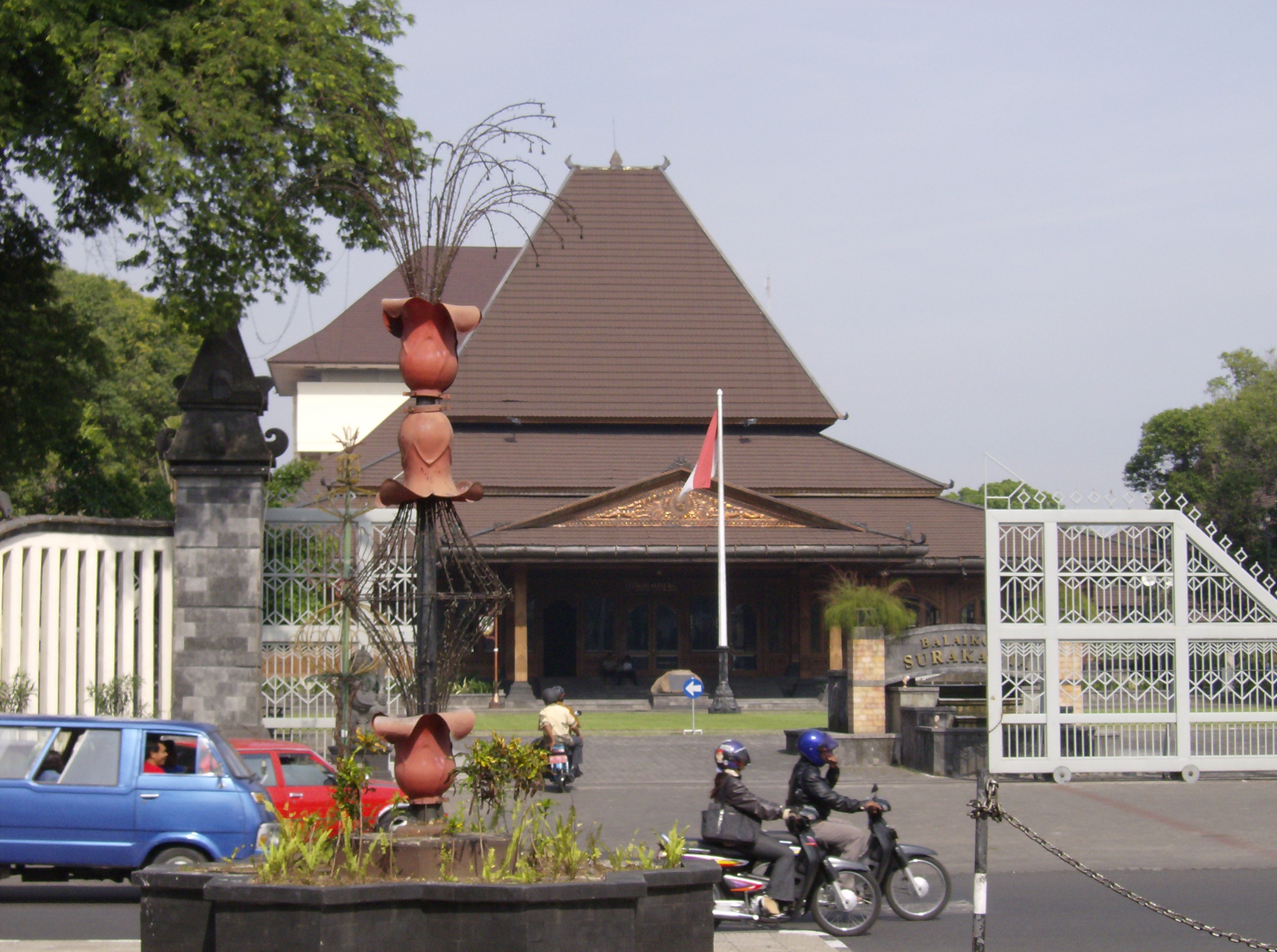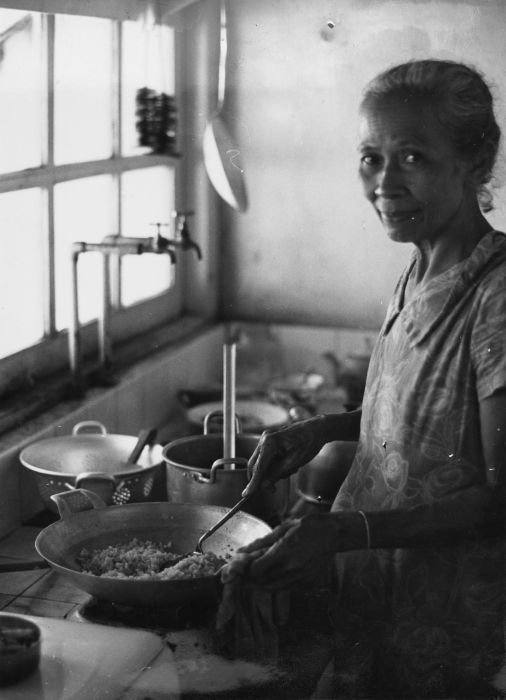|
Nasi Goreng Jawa
Nasi goreng jawa (Indonesian for Javanese fried rice, Javanese: ''sega goreng jawa'') is a Javanese-style of fried rice originated from Java, Indonesia. This dish can be found in Javanese cuisine and quite popular in Indonesia, especially Java. Commonly, this rice dish uses sambal ulek as seasoning and has a spicy taste. Variation * Nasi goreng babat from Semarang which is slightly brown in color with tripe as a side dish. * Nasi goreng Solo (Central Java) which is pink in color with a side dish of cabbage and shredded free-range chicken. * Nasi goreng Surabaya which is red-brown in color, the portion is large, and slightly spicy with a side dish of sliced omelet and chicken. * Nasi goreng kampung from Yogyakarta which is red in color with side dishes of sunny-side up eggs and free-range chicken. See also * Fried rice ** List of fried rice dishes * Cuisine of Indonesia * Nasi goreng * Nasi goreng pattaya * Nasi minyak Nasi minyak ( Palembang Malay for "oily rice") is an I ... [...More Info...] [...Related Items...] OR: [Wikipedia] [Google] [Baidu] |
Surakarta
Surakarta ( jv, ꦯꦸꦫꦏꦂꦠ), known colloquially as Solo ( jv, ꦱꦭ; ), is a city in Central Java, Indonesia. The 44 km2 (16.2 sq mi) city adjoins Karanganyar Regency and Boyolali Regency to the north, Karanganyar Regency and Sukoharjo Regency to the east and west, and Sukoharjo Regency to the south. On the eastern side of Solo lies Solo River (Bengawan Solo). Its built-up area, consisting of Surakarta City and 59 districts spread over seven regencies ("Greater Solo Area", formerly Special Region of Surakarta), was home to 3,649,254 inhabitants as of 2010 census, around half million of which reside in the city proper. Surakarta is the birthplace of the current President of Indonesia, Joko Widodo. He served as Mayor of Surakarta from 2005 to 2012. History Hominid habitation in the region of Surakarta is evidenced from roughly one million years ago, the age of the "Java Man" skeleton found 80 kilometers upstream. Another famous early hominid from this area is called ... [...More Info...] [...Related Items...] OR: [Wikipedia] [Google] [Baidu] |
Semarang
Semarang ( jv, ꦏꦸꦛꦯꦼꦩꦫꦁ , Pegon: سماراڠ) is the capital and largest city of Central Java province in Indonesia. It was a major port during the Dutch colonial era, and is still an important regional center and port today. The city has been named as the cleanest tourist destination in Southeast Asia by the ASEAN Clean Tourist City Standard (ACTCS) for 2020–2022. It has an area of and is located at . The population of the city was 1,555,984 at the 2010 censusBiro Pusat Statistik, Jakarta, 2011. and 1,653,524 at the 2020 census,Badan Pusat Statistik, Jakarta, 2021. making it Indonesia's ninth most populous city after Jakarta, Surabaya, Bekasi, Bandung, Medan, Depok, Tangerang and Palembang. The built-up urban area had 3,183,516 inhabitants at the 2010 census spread over two cities and 26 districts. The Semarang metropolitan area (a.k.a. ''Kedungsepur'') has a population of over 6 million in 2020 (''see Greater Semarang section''). The population of the cit ... [...More Info...] [...Related Items...] OR: [Wikipedia] [Google] [Baidu] |
Nasi Minyak
Nasi minyak ( Palembang Malay for "oily rice") is an Indonesian dish from Palembang cuisine of cooked rice with ''minyak samin'' ( ghee) and spices. This rice dish is commonly associated with Palembang city, the capital of South Sumatra province. However, it is also common in neighboring Jambi as far north to Medan in North Sumatra. Nasi minyak looks and tastes similar to nasi kebuli, this is because both rice dishes are influenced by Indian and Middle Eastern cuisines, as evidence in the use of ghee and certain spices. ''Bumbu'' spice mixture being used including cardamom, anise, clove, caraway, cinnamon, onion, garlic and curry powder. In Palembang, nasi minyak is a celebrative traditional dish usually served for special events and celebrations. Certain mosque in Palembang served free nasi minyak after Jumu'ah Friday mass prayer, every last Friday of the month. While in Southern Thailand, Peninsular Malaysia and Singapore, the Nasi Minyak is regarded ceremonial dish an ... [...More Info...] [...Related Items...] OR: [Wikipedia] [Google] [Baidu] |
Nasi Goreng Pattaya
Nasi goreng pattaya, or simply nasi pattaya, is a Southeast Asian fried rice dish made by covering or wrapping chicken fried rice, in thin fried egg or omelette. Despite its name, the dish is believed to originate from Malaysia, and today is also commonly found in Indonesia and Singapore. It is often served with chili sauce, tomato ketchup, slices of cucumber, and '' keropok''. In Indonesia this kind of ''nasi goreng'' is often called ''nasi goreng amplop'' (enveloped fried rice), since the ''nasi goreng'' is enveloped within a pocket of thin omelette. However, due to proximity and neighbouring influences, today this kind of fried rice is often also called as ''nasi goreng pattaya'' in Indonesia. Today, the dish is popular throughout Southeast Asia, it is one of the fried rice variants favourite in Malaysia, Indonesia and Singapore. Etymology and origin The name is believed to be derived from Pattaya, a popular beach resort in Thailand. However, despite its Thai-sounding ... [...More Info...] [...Related Items...] OR: [Wikipedia] [Google] [Baidu] |
Nasi Goreng
''Nasi goreng'' (English pronunciation: ) is a Southeast Asian fried rice dish, usually cooked with pieces of meat and vegetables. One of Indonesia's national dishes, it is also eaten in Malay-speaking communities in countries such as Malaysia, Singapore and Brunei, and has gained popularity in Sri Lanka through migrations from the Malay Archipelago, in countries like Suriname via Indonesian immigrant communities, and in the Netherlands through its colonial ties with Indonesia. ''Nasi goreng'' is distinguished from other Asian fried rice preparations by its distinct smoky aroma, and caramelised yet savoury undertones of flavour. There is no single defined recipe for ''nasi goreng'', and its composition and preparation varies greatly from household to household. ''Nasi goreng'' has long been considered an important staple of Indonesian cuisine. In 2018, it is officially recognized by the Indonesian government as one of the country's five national dishes. A ubiquitous meal thr ... [...More Info...] [...Related Items...] OR: [Wikipedia] [Google] [Baidu] |
Cuisine Of Indonesia
Indonesian cuisine is a collection of various regional culinary traditions that formed the archipelagic nation of Indonesia. There are a wide variety of recipes and cuisines in part because Indonesia is composed of approximately 6,000 populated islands of the total 17,508 in the world's largest archipelago,"Indonesian Cuisine." . Accessed July 2011. [...More Info...] [...Related Items...] OR: [Wikipedia] [Google] [Baidu] |
List Of Fried Rice Dishes
Fried rice is a dish of cooked rice that has been stir-fried in a wok or a frying pan and is usually mixed with other ingredients such as eggs, vegetables, seafood, or meat. It is often eaten by itself or as an accompaniment to another dish. Fried rice is a popular component of East Asian, Southeast Asian and certain South Asian cuisines, as well as a staple national dish of Indonesia. As a homemade dish, fried rice is typically made with ingredients left over from other dishes, leading to countless variations. Fried rice first developed during the Sui Dynasty in China and as such all fried rice dishes can trace their origins to Chinese fried rice. Many varieties of fried rice have their own specific list of ingredients. In Greater China, common varieties include Yangzhou fried rice and Hokkien fried rice. Japanese chāhan is considered a Japanese Chinese dish, having derived from Chinese fried rice dishes. In Southeast Asia, similarly constructed Indonesian, Malaysian, and S ... [...More Info...] [...Related Items...] OR: [Wikipedia] [Google] [Baidu] |
Yogyakarta
Yogyakarta (; jv, ꦔꦪꦺꦴꦒꦾꦏꦂꦠ ; pey, Jogjakarta) is the capital city of Special Region of Yogyakarta in Indonesia, in the south-central part of the island of Java. As the only Indonesian royal city still ruled by a monarchy, Yogyakarta is regarded as an important centre for classical Javanese fine arts and culture such as ballet, ''batik'' textiles, drama, literature, music, poetry, silversmithing, visual arts, and '' wayang'' puppetry. Renowned as a centre of Indonesian education, Yogyakarta is home to a large student population and dozens of schools and universities, including Gadjah Mada University, the country's largest institute of higher education and one of its most prestigious. Yogyakarta is the capital of the Yogyakarta Sultanate and served as the Indonesian capital from 1946 to 1948 during the Indonesian National Revolution, with Gedung Agung as the president's office. One of the districts in southeastern Yogyakarta, Kotagede, was the capital of t ... [...More Info...] [...Related Items...] OR: [Wikipedia] [Google] [Baidu] |
Surabaya
Surabaya ( jv, ꦱꦸꦫꦧꦪ or jv, ꦯꦹꦫꦨꦪ; ; ) is the capital city of the Provinces of Indonesia, Indonesian province of East Java and the List of Indonesian cities by population, second-largest city in Indonesia, after Jakarta. Located on the northeastern border of Java island, on the Madura Strait, it is one of the earliest port cities in Southeast Asia. According to the Government of Indonesia, National Development Planning Agency, Surabaya is one of the Regions of Indonesia#Development regions, four main central cities of Indonesia, alongside Jakarta, Medan, and Makassar. The city has a population of 2.87 million within its city limits at the 2020 census and 9.5 million in the extended Surabaya metropolitan area, making it the List of metropolitan areas in Indonesia, second-largest metropolitan area in Indonesia. The city was settled in the 10th century by the Janggala, Kingdom of Janggala, one of the two Javanese kingdoms that was formed in 1045 when ... [...More Info...] [...Related Items...] OR: [Wikipedia] [Google] [Baidu] |
Tripe
Tripe is a type of edible lining from the stomachs of various farm animals. Most tripe is from cattle, pigs and sheep. Types of tripe Beef tripe Beef tripe is made from the muscle wall (the interior mucosal lining is removed) of a cow's stomach chambers: the rumen (blanket/flat/smooth tripe), the reticulum (honeycomb and pocket tripe), and the omasum (book/bible/leaf tripe). Abomasum (reed) tripe is seen less frequently, owing to its glandular tissue content. Other animals Tripe refers to cow (beef) stomach, but includes stomach of any ruminant including cattle, sheep, deer, antelope, goat, ox, giraffes, and their relatives. , the related Spanish word, also refers to culinary dishes produced from any animal with a stomach. In some cases, other names have been applied to the tripe of other animals. For example, tripe from pigs may be referred to as ''paunch'', ''pig bag'', or ''hog maw''. Washed tripe Washed tripe is more typically known as dressed tripe. To dress th ... [...More Info...] [...Related Items...] OR: [Wikipedia] [Google] [Baidu] |
Bumbu (seasoning)
Bumbu is the Indonesian word for a blend of spices and for pastes made from these blends, and it commonly appears in the names of spice mixtures, sauces and seasoning pastes. The official Indonesian language dictionary describes ''bumbu'' as "various types of herbs and plants that have a pleasant aroma and flavour — such as ginger, turmeric, galangal, nutmeg and pepper — used to enhance the flavour of the food." It is a characteristic of Indonesian cuisine and its regional variants such as Balinese, Javanese, Sundanese, Padang, Batak and Manado cuisines. It is used with various meats, seafood and vegetables in stews, soups, barbecue, sotos, gulai, and also as an addition to Indonesian-style instant noodles. Indonesians have developed original gastronomic themes with lemongrass and galangal, cardamom and chilies, tamarind and turmeric. Unlike Indian cooking tradition that favours dried spice powder mix, Indonesian cuisine is more akin to Thai, which favou ... [...More Info...] [...Related Items...] OR: [Wikipedia] [Google] [Baidu] |





